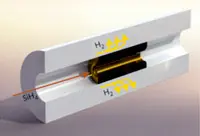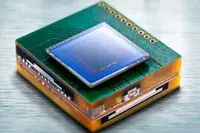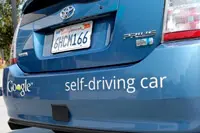Electronics News
Archive : 3 October 2014 год
 Researchers, led by the Southampton University's Optoelectronics Research Centre (ORC), believe they have made a breakthrough in the use of silicon detectors in telecommunications.
Researchers, led by the Southampton University's Optoelectronics Research Centre (ORC), believe they have made a breakthrough in the use of silicon detectors in telecommunications.
The research, reported in Nature Materials, describes how the team has engineered the electronic band structure of laser crystallised silicon photonic devices in order to overcome one of the key challenges of using silicon in data communications.
The technique, developed for the ORC's silicon optical fibre platform, shows that it is possible to crystallise the core material completely, whilst including large stresses to modify the optoelectronic properties. In this way, bandgap reductions from 1.11eV to 0.59eV are realised, enabling optical detection at wavelengths of up to 2100nm.
Incorporating silicon materials within the fibre geometry avoids the issues associated with coupling between the micron-sized fibres used for the transport of light, and the nanoscale waveguides on-chip that are employed for data processing and communications systems.
Dr Noel Healy, lead researcher, said: "Our discovery uses large variable strains to provide unprecedented control over silicon's optoelectronic properties. This greatly increases the number of potential applications for the material in both electrical and optical applications.
Author
Graham Pitcher
Source: www.newelectronics.co.uk
 Researchers in Germany have created a miniature camera module for driver assistance systems, which they say could help to reduce the number of road accidents each year caused by sleepy drivers.
Researchers in Germany have created a miniature camera module for driver assistance systems, which they say could help to reduce the number of road accidents each year caused by sleepy drivers.
Unlike conventional driver assistance technologies, the tiny camera relies on an integrated image sensor and processor to record and evaluate images.
"The video itself no longer has to – as previously the case – be sorted and analysed by an interposing system," said Andreas Ostmann, a graduate of physics at the Fraunhofer Institute for Reliability and Microintegration. "Instead, only the relevant signals are transmitted."
The advantage of this is that the amount of data transmitted and processed is significantly reduced.
Because the camera is so small (it measures just 16 x 16x 12mm3), the researchers say it can be integrated directly into the vehicle without taking up too much space.
Mounted on the dashboard, it is designed to detect driver fatigue by monitoring a user's eyelids. If they remain shut for more than ffive seconds, for example, it sends them an alert to wake them up.
"If you program the software accordingly, it is also possible to detect road markings," Ostmann continued.
"In this case, the camera is combined with a lane departure assistant. Since it also controls motion detection and detects objects such as animals, people, and their position, it can be readily coupled with a brake assistant or pedestrian safety system."
A total of 72 passive components and 13 active components, including LEDs, DC/DC converters and a memory chip, make up the device.
All of these were integrated directly into the PC board from glass fibre and epoxy resin, using a novel assembly technique called 'embedding'.
This allowed the camera to remain impervious to vibrations on uneven street surfaces.
Author
Laura Hopperton
Source: www.newelectronics.co.uk
 Google's driverless car is still attracting headlines and all the fuss has tightened the focus on the increasing amount of automation being applied in vehicles.
Google's driverless car is still attracting headlines and all the fuss has tightened the focus on the increasing amount of automation being applied in vehicles.
But what is driving the trend to the driverless car and what issues will be encountered along the way?
Will this increase in complexity force automotive manufacturers to develop a 'system of systems' approach to design, test and certification?
Find out on the first day of the Electronics Design Show (22nd October) from Dr Anthony Baxendale, MIRA's manager of Future Transport & Research.
During his keynote at 14.15pm, Dr Baxendale will offer answers to the questions above and talk in-depth about the role driverless cars have to play in the future of transport.
Interested in attending? As a New Electronics reader, you can do so for free by using the code EMB14L when you register here.
Author
Laura Hopperton
Source: www.newelectronics.co.uk

